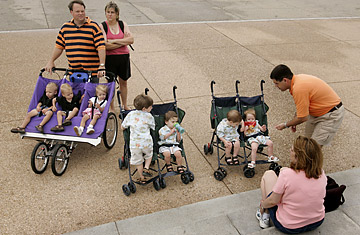
Robb and Missy Altenburg, left, and their 1-year-old triplets Noah, Jarrett and Marissa take a break next to the Marotta family — including 1-year-old triplets Jack, Michael and Caroline; Christopher, 3; and parents Katie and Joe — at the Jefferson Memorial in Washington
Just about the time that eight babies began growing inside a California woman's womb, some nationwide policies about fertility treatment were being codified. In June, the American Society for Reproductive Medicine (ASRM) issued updated "Guidelines on Number of Embryos Transferred." Women under age 35 — the octuplets' mom is reportedly 33 — should attempt to transfer no more than two, and preferably only one, fertilized embryo at a time. Women over age 40 should attempt no more than five. (See pictures of multiple births.)
How the California woman, apparently a single mother who already has six young children, including a set of twins, got pregnant is the subject of rampant speculation. But regardless of whether the octuplets are the result of in vitro fertilization (IVF) or fertility drugs — the latter has historically been available on the cheap in Mexico — there is little doubt that from a medical and ethical perspective, something went very wrong. And fertility specialists now find themselves on the defensive, trying to fend off the perception that theirs is an undisciplined, irresponsible profession. (See five truths about health care in America.)
"I think the word cowboys comes to mind," says Robert Stillman, medical director at Shady Grove Fertility Center in Rockville, Md., the country's largest fertility clinic.
But fertility doctors counter that reproductive medicine is among the most regulated specialties in the U.S. Clinics must report to the Centers for Disease Control and Prevention the number of embryos transferred in each IVF cycle — in which sperm and egg are fertilized outside a woman's body, then transferred to her uterus — as well as the number of babies born as a result of that treatment cycle. (Read "A Brief History Of: Multiple Births.")
This requirement was originally set up to empower patients, who can now assess their chances of getting pregnant on the basis of a particular clinic's success rate. But the reporting system has evolved into being a way to monitor a clinic's number of multiple births, which are more dangerous — and more costly — for mother and baby.
In the past decade, the number of multiple births resulting from IVF cycles has declined even as the number of IVF cycles has increased. As the science of IVF has improved, the Society of Assisted Reproductive Technology, an affiliate of the ASRM, has progressively lowered its recommendations regarding how many embryos should be transferred in each cycle. According to the group, IVF-facilitated births of three or more babies dropped 69% from 1996 to 2005. That's no coincidence: in the same period, the average number of embryos transferred went from 3.9 to 2.4, a 38% drop. (Read "Calculating the Odds of a Baby Through IVF.")
Single-embryo transfers are now the name of the game in many cases. A recent article in the journal Fertility and Sterility generated controversy when it suggested recasting how fertility clinics view outcomes. A singleton birth should be considered a success, triplets a failure.
But in the U.S., where fertility treatment is often scoffed at by insurance companies, women paying for the costly procedures out of pocket want to wind up with a baby as quickly — and cheaply — as possible. One IVF cycle can cost upwards of $10,000. Often, women decide their best shot is by increasing the number of embryos transferred.
Physicians may advise a patient to transfer only one or two embryos, but the patient may insist on double the number — or more. "Doctors' attorneys are advising them, 'You have to do it,' " says Sean Tipton, spokesman for the ASRM. "The courts have made clear that decisions about what to do with embryos are in the hands of patients, not in the hands of physicians."
A doctor, after all, is not the same as a judge.
If women who already have a bunch of kids were to approach Stillman for help conceiving more, he says he'd be obligated to help. "As a parent of two kids, I may think they're crazy, but I'd tell them what I always tell patients: our goal here is as many children as you want, but preferably one at a time."
